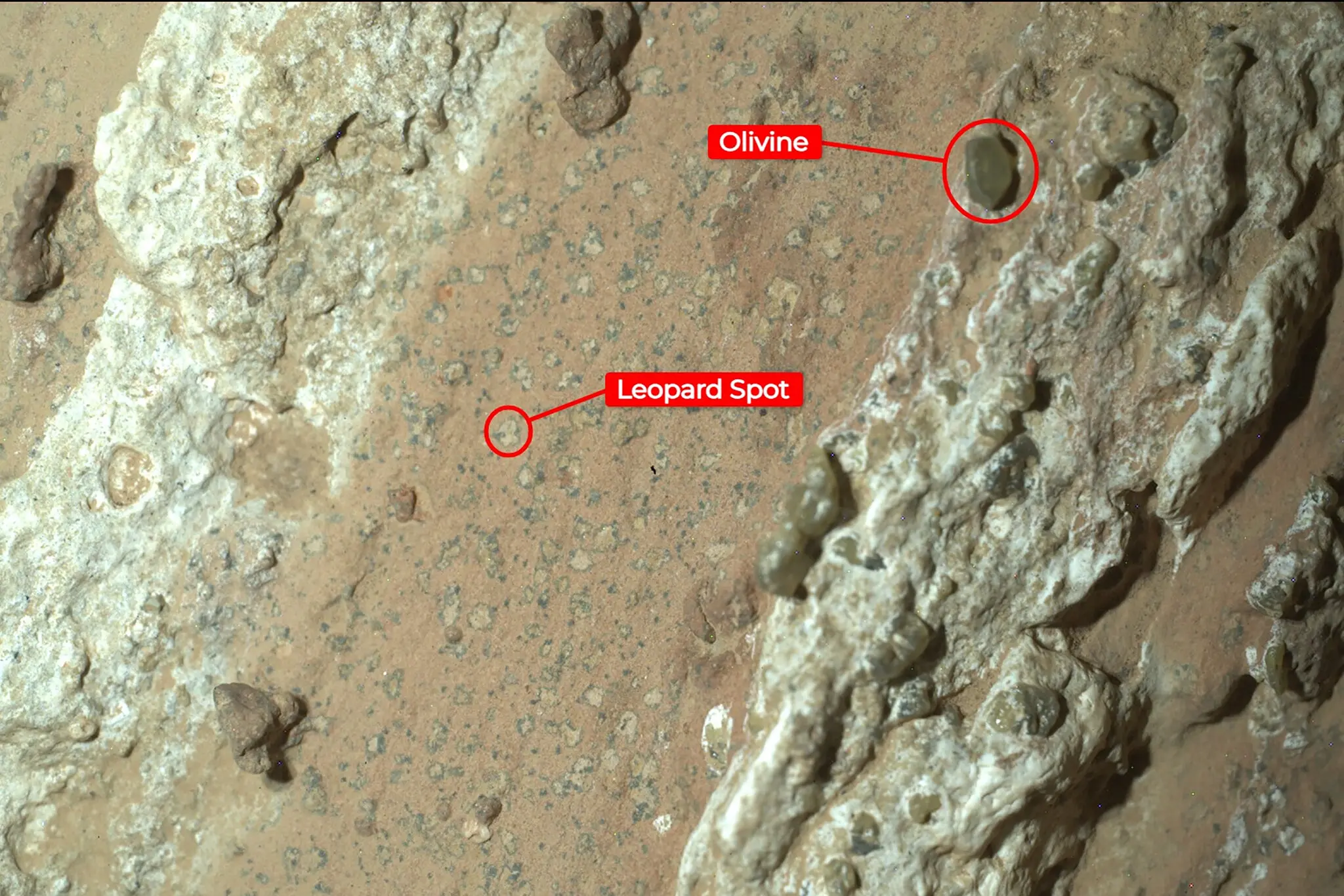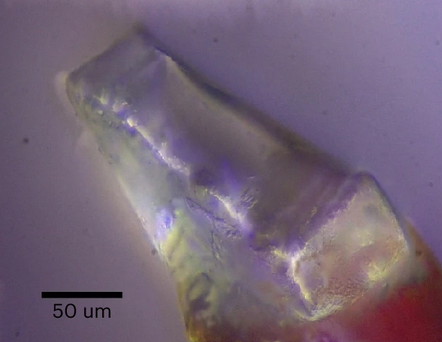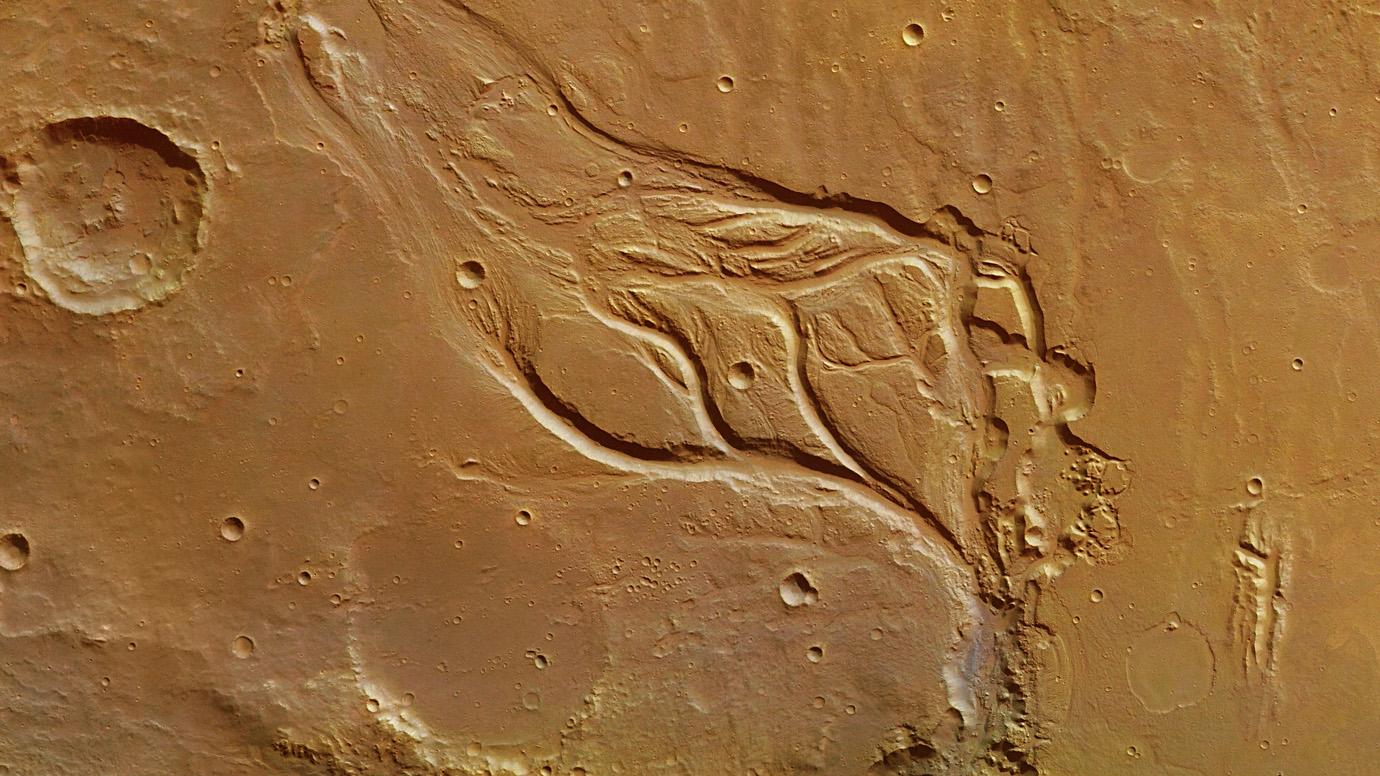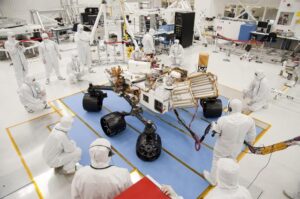Three different robotic explorers made planetary news last week. The discoveries of Perseverance, Curiosity, and Chang’e 5 are reshaping our understanding of conditions on Mars and the moon billions of years ago. From possible microbial signatures to extraterrestrial water records, here are the latest insights from outer space.
Possible Martian biosignatures
There’s no debate over whether life exists off Earth. Without a doubt, it does. The question is: Does any life exist off Earth that we didn’t put there?
While earthly microbial hitchhikers from probes gallivant around the moon, a white-striped rock on Mars might hold traces of true Martians — now long dead. On Thursday, NASA announced that the Perseverance rover had discovered the rock in question in Neretva Vallis.
Nowadays, Neretva Vallis is a barren riverbed of dust and rocks. But three billion years ago, it poured water into a lake at the dry crater bed known as Jezero Crater. It’s here that Perseverance found the strange rock. Somewhat confusingly, the NASA team named the rock itself Cheyava Falls, after the tallest waterfall in the Grand Canyon.

An elevation map of Jezero Crater, thought to be an ancient lake. Neretva Vallis runs into the crater from the left. Photo: NASA/Tim Goudge
The chemistry of the rock suggests a perfect climate for ancient life. Streaks of calcium sulfate run over it, hinting that it used to be submerged in flowing water.
Organic compounds also dot the surface of the rock. These carbon-bearing molecules were vital to the formation of life on Earth. Astronomers have identified them in the earliest stages of star formation and in comets, but we rarely see them on Mars. Their presence in this rock adds another of life’s building blocks to our picture of ancient Neretva Vallis.
Leopard spots
And then there are the “leopard spots.” That’s what the Perseverance team is calling the little white dots with black rings containing iron phosphate. The leopard spots might have formed through the reaction of hematite and organic compounds. On Earth, reactions like this fed emerging microbial life. Could the same have happened on Mars?
We won’t know until we get Perseverance’s sample of Cheyava Falls back to Earth, where scientists can examine it in a lab for subsurface microbial fossils. But Perseverance’s sample return mission isn’t a certainty. Beset by budget issues, its fate is up to the U.S. Congress. The House of Representatives just passed a draft budget for NASA that included $650 million to get Perseverance’s samples back to Earth, but it’s likely the Senate will counter with a lower suggestion. Knowledge of life on Mars may depend on terrestrial bureaucracy.

The surface of the rock the Perseverance team has nicknamed ‘Cheyava Falls.’ Photo: NYT/NASA/JPL-Caltech/MSSS
Pure sulfur on Mars
While Perseverance carefully maneuvered the channel leading to an ancient lake, its sibling Curiosity was almost 4,000km away in an old riverbed called Gediz Vallis. Unlike Neretva Vallis, the geological record in Gediz hints at a time when Mars’ water was dwindling. Salty compounds line thin, meandering streambeds between sandy hills. Here, Curiosity lurched over an unobtrusive rock that cracked open to reveal crystals of pure yellowish sulfur. When the Curiosity team examined the surroundings, they realized the rover was sitting in a field full of sulfur geodes.

Pure sulfur crystals from inside a Martian rock. Photo: NASA/JPL-Caltech/MSSS
Curiosity was looking for sulfates, salty minerals containing sulfur, and other elements. Sulfates form when water evaporates. But these weren’t diluted sulfates from Mars’ dwindling streams. This was pure, crystalline sulfur — and a lot of it. On Earth, most naturally occurring pure sulfur originates in structures called salt domes, which don’t appear at all in this region of Mars. So how did it get there? We’ll have to wait for more clues as Curiosity charts the history of the last water on Mars.
Chang’e 5 put lunar water on Earth for the first time
A month ago, we covered the China National Space Agency’s (CNSA) retrieval of samples from the dark side of the Moon and what they might indicate about our solar system’s history. While we’re waiting for news from tests on the far-side samples, near-side samples from the CNSA’s previous lunar probe, Chang’e 5, have a story to tell. A team just announced that Chang’e 5’s near-side samples contain novograblenovite, a volcanic mineral that is 41% water by weight.

A strange lunar mineral appears to be novograblenovite. Photo: Jin et al., 2024
No previous lunar samples had water molecules in them. The Apollo 11 samples contained hydroxide (an oxygen atom bonded with a hydrogen ion), a byproduct of water molecules breaking apart. That, along with remote observations of water ice at the poles, confirmed that the moon is not devoid of water like we long thought. But we’ve never before been able to examine lunar water in labs on Earth.
Water isn’t all the samples showed. The minerals were rich in ammonium, which may have formed when lava on the surface reacted with water, hydrogen chloride, and ammonia gas. Taken together, these findings suggest a steamy magma ocean on the early moon, replete with water in different states.
A changing picture
For many decades, observations of nearby planetary bodies painted a bleak picture of our corner of the solar system. Not only did Earthlings appear to be alone in the present, but the conditions on our moon and neighboring planets seemed antithetical even to past extraterrestrial life.
That picture is changing. It started with the 1972 Mariner mission, which showed dry riverbeds on the surface of Mars. The more our abilities improve in aeronautics and remote sensing, the more we’re learning about the time over three billion years ago when Mars looked a lot more like a young Earth.
The moon, long thought to be utterly dry, also tells a more complicated story the better we get at listening. Water and ammonia vapor may have been prevalent, interacting with a magma ocean and leaving traces all over the moon’s surface. With low oxygen and high volcanic activity, this picture of the moon takes us back even further to the first 500 million years of the Earth’s history.
The Earth may still be alone. But at least it hasn’t always been special.






